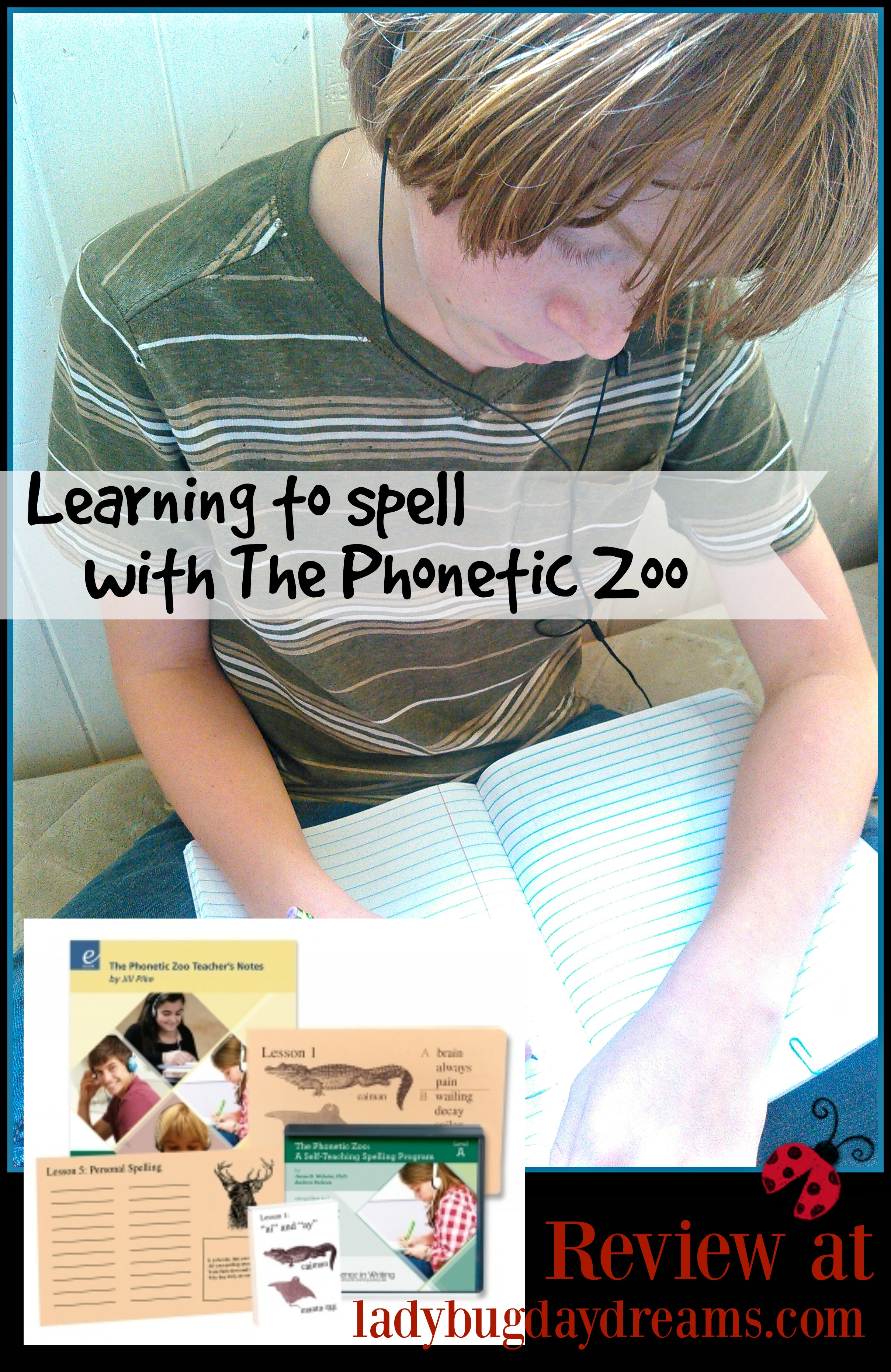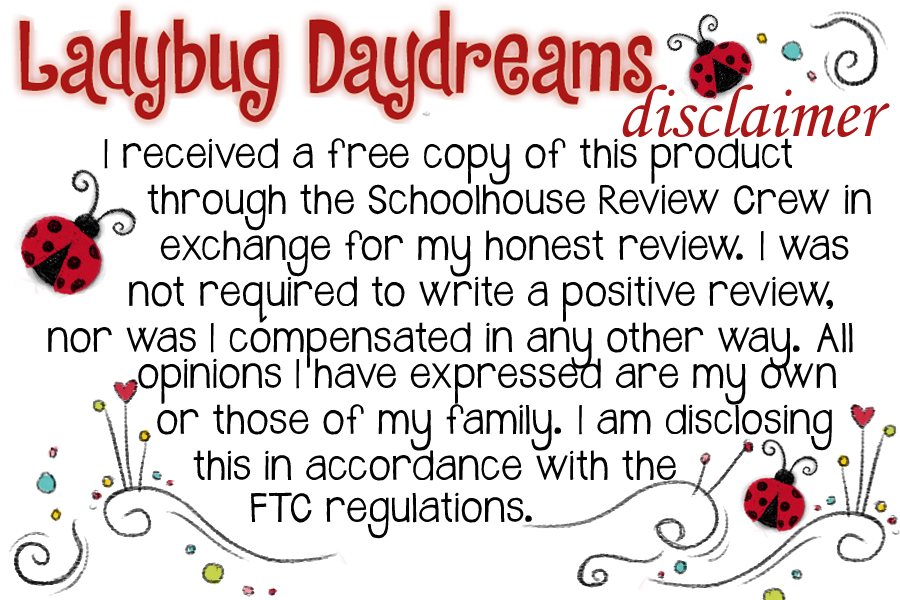It’s no secret that I love the products put out by the Institute for Excellence in Writing (IEW). It’s also no secret that my oldest, Seahawk (who turns 12 tomorrow and is in 6th grade) needs a lot of help with his spelling. Despite the fact that he reads a lot, he just hasn’t been able to put seeing all the words into practical terms in relation to spelling. When I learned that the newest Crew offering from IEW was going to be a spelling program, therefore, of course I was thrilled. We’ve had only good luck using IEW’s products, so I had incredibly high hopes that The Phonetic Zoo Level A [Starter Set] would finally be the program to help Seahawk gain some success in his spelling. On the other hand, though, I was a little concerned that since we’ve tried so many different programs that this one might not make the grade.
So what’s the verdict? Has it worked better than other programs for my struggling speller? Keep reading to find out!
The Phonetic Zoo has three levels: A, B, and C. Despite the fact that he was technically outside of the age range for level A, I chose this level for Seahawk anyway. I made the decision after having him take the spelling placement test on the IEW website and seeing that he definitely needed to start at the beginning – his spelling was that poor.
The program is broken down into three portions: the printed materials, the audio CDs, and the downloadable components. The printed materials cover all three levels, so you only need to purchase those once for the entire time your child or children are using the program. The audio CDs vary from level to level, so those need to be purchased new each time your child ascends to a new level. The printed materials include teacher cards and student motivation cards (more explanation on each component later). The audio CDs are just that: a set of 5 CDs that include the audio portion of the program. These are also available as MP3 downloads, which are automatically included with the CD purchase. And finally, the downloadable components include the teacher manual and an audio version of Andrew Pudewa’s talk “Spelling and the Brain.” (If you’re a more visual person, this speech is also available in its entirety on IEW’s YouTube channel.)
The teacher cards are large (8×5 or so) flashcards. The side you show to the student has pictures of the animal(s) whose name demonstrates the rule being studied and a small selection from each list (levels A, B, and C), while the other has the rule and its jingle along with the complete list for each level. These cards have a single hole punched in them so you can attach them to a large ring for easy storage. The student cards are much smaller (about business card sized, but not exactly) and have the animal on one side and the rule/jingle on the other. When a student successfully completes a lesson (details on that in a minute), they keep the card and add it to their “zoo.”
The first thing I did when I found out we would be on this review was to hop over to YouTube and listen to the Spelling and the Brain speech, even before I had my download access. This was a fascinating talk explaining how the brain works and why that’s important for learning to spell. Then there was the matter of waiting on the mail so we could dive into the program. It arrived on the first or second day of school, so that was perfect timing. We started the program the day after it arrived (I’d already received the downloadables by then, so I’d spent some time with the teacher manual and felt ready to explain it to Seahawk). One thing to keep in mind is the things you’ll need that aren’t included in the purchase: a notebook or binder with blank paper and a CD or MP3 player with headphones. (I ripped our CDs to Windows Media Player on the computer, then moved the files from there to Seahawk’s MP3 player since we don’t have a CD player except in the car.) The curriculum authors emphasize the importance of headphones rather than a regular speaker because the sound gets right into the student’s ears – and brain – better that way. Plus there are fewer options for distraction.
So, the way the program works is pretty simple, and it’s something the student can do autonomously (mostly). The first day, the teacher goes over the new rule with the child. (The rules are very much the same as those that my generation learned in school – “I before E except after C,” “When two vowels go walking, the first one does the talking,” and so forth.) The difference between just learning the rules and The Phonetic Zoo’s way of teaching them is that IEW puts an emphasis on making sure students understand that there are exceptions to every rule. This is important for students to comprehend in order for them to really excel. Once the rule has been explained to the student, they’re on their own. They put their headphones on or earbuds in and play the track with the list of words for that lesson. The CD explains the rule to the student again, and then the list is started. There’s a pause between each word, but students are also encouraged to pause their CD if they need more time. This isn’t supposed to be a rush job. They write down the words on their blank paper, one at a time. Then they listen to the next track, which is the correction track for the lesson. In this track, each word is named and then spelled. This is a very important piece of the puzzle for two reasons. First, it allows the students to self-correct. Second, by hearing the letters in the proper order, students can begin to make sense of the words and rules, specifically the exceptions. While they listen to the correction track, students are encouraged to write down the proper spelling of each word, even if they spelled it correctly the first time. Children work the same lesson each day until they get 100% correct for two consecutive days. Why two? Because one could be a fluke, but two in a row demonstrates true understanding.
We used this program exactly as it’s designed to be used, and how I described it in this post. Seahawk did one lesson each school day (four times per week) until he got 100% for two consecutive days – even if that meant his “correct” days were split over the weekend. Sometimes this took only 3 or 4 days, other times it took upwards of 10-12 days.
So, after all of this… what do we think of the program? We like it a lot. It’s easy to follow, and Seahawk likes the autonomy of not needing to wait until I’m available to get the work done. He can just get on his MP3 player and start working. Each day’s work only takes about 10-15 minutes, so that’s a good thing too. Will it work for him long-term? I’m still not sure. So far, he’s only made it through 3 lessons despite the fact that we’ve been working on it for six weeks. But he doesn’t get fatigued, even when doing the same lesson for days and days in a row. To the contrary, he’s very motivated because he knows that he’s building skills, and that he’ll get a new set of words as soon as he masters the current one. My only concern is that while the program emphasizes learning the rules – and exceptions – of English spelling, it does so using lists of words. I worry that he’s learning the words rather than the rules, but I haven’t tested that theory yet. If I remind him of a rule he’s already learned while he’s writing for another subject, he can usually come up with the correct spelling, even if the word giving him trouble wasn’t on the initial list. But he’s not yet at a point where he’s remembering those rules outside of spelling lessons. I hope to see that change over the course of using the curriculum.
All that said, I will say that Seahawk has now passed spelling tests six times (three lessons, two 100% scores each). This is huge, because before this program he’d passed zero. He’s feeling pretty motivated that he’s actually having some success, and I plan to capitalize on that momentum as much as possible. What this means is that we will definitely continue to use the program. It’s showing more promise than any spelling curriculum we’ve tried to date, and that’s enough for me at this point.
Blessings,
All three levels of The Phonetic Zoo are being reviewed this weekend at the Schoolhouse Review Crew blog. In addition to the spelling program, some members also had the opportunity to review a series of teacher resources including the Timeline of Classics (putting classical literature in chronological order), A Word Write Now (a thematic thesaurus), and Teaching with Games (a video course that teaches teachers to create games for their students). Make sure to click the banner below for more information on all of those products!




